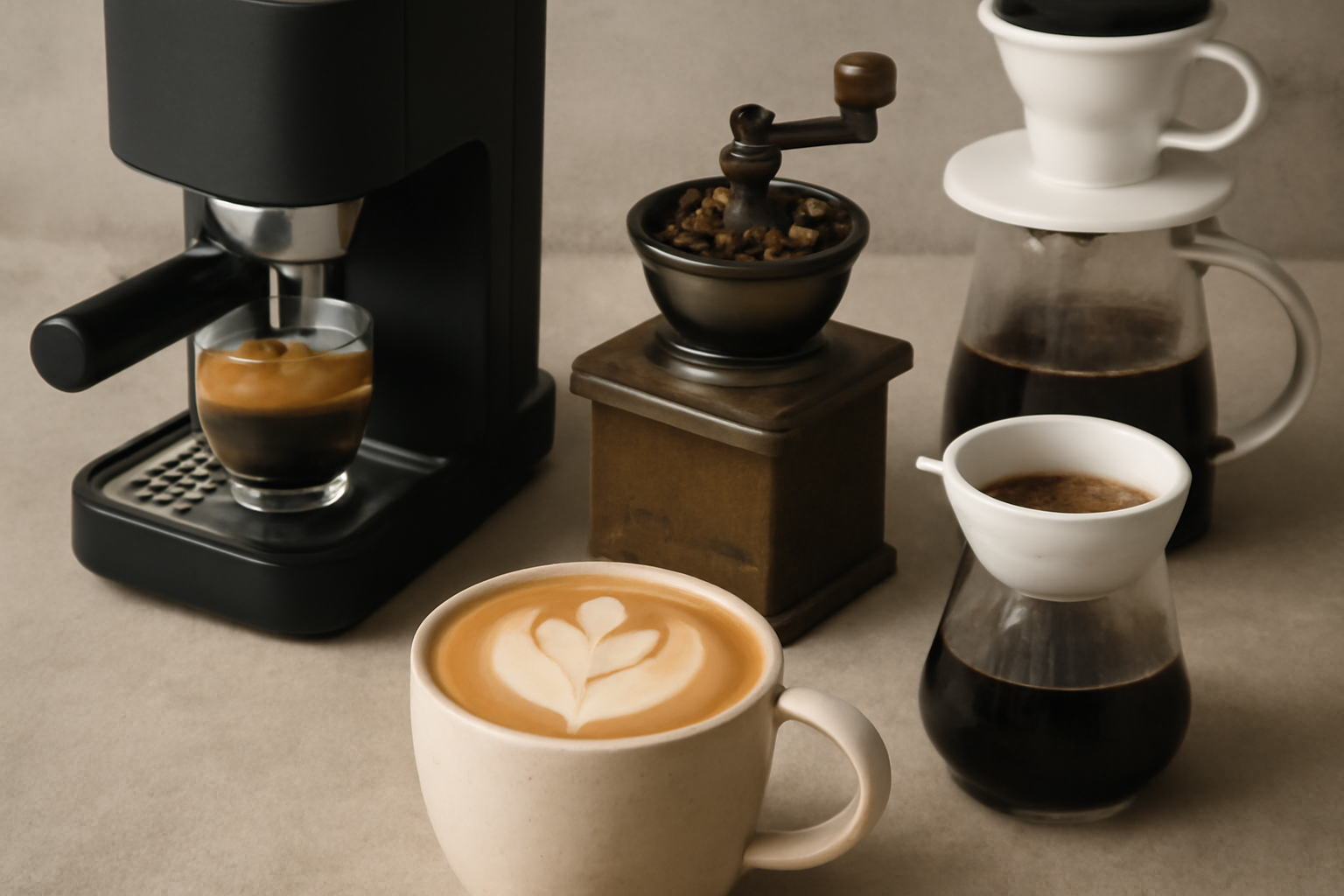Coffee is more than just a drink—it’s a ritual, an experience, and for many, a necessary part of daily life. Whether you’re brewing a cup to kickstart your day or preparing a rich espresso for your afternoon break, the type of coffee you choose has a significant impact on the final result. When you’re making coffee at home, the possibilities are endless, but the key to a great cup starts with choosing the right coffee beans. In this comprehensive guide, we’ll explore how to select the best coffee for brewing at home, no matter your method or level of expertise. From understanding different types of coffee beans to choosing the right roast and brewing method, this guide has everything you need to make a flavorful cup of coffee in the comfort of your home.
1. Know the Different Types of Coffee Beans
Before you even begin brewing your coffee, it’s essential to understand the different types of coffee beans available on the market. Coffee beans are divided into four main varieties, each with its unique characteristics. Understanding these varieties will help you choose the one that best suits your flavor preferences.
Arabica Beans
Arabica beans are the most commonly grown and consumed coffee beans in the world, known for their smooth, mild flavor and balanced acidity. These beans tend to have fruity and sweet flavors with floral undertones, making them an excellent choice for lighter roasts. Arabica coffee is often considered the superior bean due to its high-quality taste profile and smoother flavor.
Arabica coffee beans are typically grown at higher altitudes and in cooler climates, which contribute to their complex flavors. They are also known for having lower caffeine content compared to other varieties, making them a favorite for those who prefer a milder cup of coffee.
Robusta Beans
Robusta beans are the second most popular coffee variety, known for their stronger, bolder flavor and higher caffeine content. These beans have a more intense, sometimes bitter taste with earthy and woody notes, which make them ideal for those who enjoy a robust, full-bodied coffee.
Robusta beans are often used in espresso blends to create a stronger, more intense cup, and they are typically grown at lower altitudes in warmer climates. The higher caffeine content in Robusta also makes it a more resilient plant, as caffeine acts as a natural pest repellent.
Liberica Beans
Liberica beans are a lesser-known variety of coffee, but they offer a unique flavor profile. These beans have a smoky, woody taste with hints of fruit and spice, giving them a more distinct flavor than Arabica or Robusta. Liberica coffee is less common in mainstream coffee shops, but it’s often sought after by adventurous coffee drinkers.
Liberica beans are typically grown in tropical regions, particularly in the Philippines and Malaysia, where the hot, humid climate helps develop their distinctive flavors. If you’re looking to try something new and different, Liberica coffee may be worth exploring.
Excelsa Beans
Excelsa beans are often considered a subtype of Liberica beans. They are known for their complex, fruity flavors, which can range from tart and tangy to sweet and floral. Excelsa beans are typically grown in Southeast Asia and are used primarily in blends to add depth and complexity to the coffee.
If you enjoy coffees with a vibrant, unique flavor, Excelsa beans may be an excellent choice for you. They are not as widely available as Arabica or Robusta beans, but you can often find them in specialty coffee shops or online.
2. Consider the Roast Level
Once you’ve chosen the right type of coffee bean, the next step is deciding on the roast level. The roast level of your coffee determines the flavor profile and overall strength of the brew. There are three main types of roasts: light, medium, and dark.
Light Roast
Light roasts are known for their delicate flavors and higher acidity. These beans are roasted for a shorter amount of time, which preserves the original flavors of the coffee, including fruity, floral, and citrus notes. Light roast coffees are often more complex and aromatic, making them ideal for those who enjoy exploring the natural flavors of coffee.
If you prefer a coffee with bright, tangy flavors, a light roast is your best choice. These roasts are often used for methods like pour-over and AeroPress, which highlight the intricate flavors of the beans.
Medium Roast
Medium roasts strike a balance between the natural flavors of the beans and the rich, roasted notes that come from the roasting process. These coffees have a more rounded, balanced flavor with hints of chocolate, caramel, and nuts. Medium roasts tend to have a medium level of acidity and are popular for both drip brewing and espresso.
If you’re new to coffee and want something that offers a bit of everything, medium roast is a safe and versatile choice. It’s ideal for those who want a smooth and flavorful cup without the bright acidity of a light roast or the bitterness of a dark roast.
Dark Roast
Dark roasts are characterized by their bold, smoky flavors and low acidity. These beans are roasted for a longer period, resulting in a coffee with a deep, intense flavor profile. Dark roasts often have notes of chocolate, caramel, and even a slight bitterness, making them perfect for those who enjoy a strong, robust cup of coffee.
Dark roast coffee is commonly used in espresso blends because its rich, full-bodied flavor stands up well to milk and cream. If you enjoy a strong, bitter coffee with less acidity, a dark roast may be the right choice for you.
3. The Importance of Freshness
When it comes to coffee, freshness is key. The flavor of coffee deteriorates over time, especially once the beans are ground. For the freshest and most flavorful cup, always purchase whole beans and grind them just before brewing.
Grinding Coffee Beans
Coffee should be ground just before brewing to preserve the essential oils and flavors that are released during the grinding process. The grind size you use depends on your brewing method:
- Espresso: Fine grind.
- French Press: Coarse grind.
- Pour-over: Medium grind.
- AeroPress: Medium to fine grind.
If you’re not sure which grind size to use, start with a medium grind and adjust based on your brewing method and taste preferences.
Storing Coffee Beans
To maintain the freshness of your coffee, it’s important to store your beans properly. Keep them in an airtight container away from light, heat, and moisture. Avoid storing coffee beans in the fridge, as this can cause them to absorb moisture and odors. A cool, dark pantry is the best place to store your coffee.
4. Consider the Brewing Method
The method you use to brew your coffee has a significant impact on the flavor and quality of your cup. Different brewing methods extract different flavors from the coffee, so it’s important to choose a method that complements your coffee beans.
Espresso Machine
An espresso machine is ideal for those who prefer a rich, concentrated coffee. Espresso requires finely ground coffee and high pressure to extract the full flavor of the beans. An espresso machine can be an investment, but it allows you to create a variety of coffee drinks, from straight espresso shots to lattes and cappuccinos.
French Press
The French press is a simple and effective way to brew coffee. It uses a coarse grind and steeping process to extract a full-bodied cup of coffee. French press coffee tends to have a richer, smoother flavor due to the oils released during brewing. It’s perfect for those who enjoy a strong, flavorful cup of coffee without the need for specialized equipment.
Pour-Over
Pour-over brewing is a manual method that involves slowly pouring hot water over ground coffee in a filter. This method is popular for its ability to produce a clean, balanced cup of coffee that highlights the delicate flavors of the beans. Pour-over brewing is ideal for lighter roasts and those who enjoy a more nuanced cup of coffee.
Cold Brew
Cold brew coffee is made by steeping coarsely ground coffee in cold water for an extended period, usually 12-24 hours. This method produces a smooth, low-acid coffee that’s perfect for iced coffee lovers. Cold brew coffee is less bitter and more mellow than hot brewed coffee, making it an excellent option for those who prefer a smooth, refreshing cup.
5. Explore Different Coffee Origins
The origin of your coffee beans plays a significant role in the flavor profile. Coffee beans grown in different regions of the world have distinct characteristics due to the climate, altitude, and soil conditions. Here are a few popular coffee origins and their flavor profiles:
Ethiopian Coffee
Ethiopian coffee is known for its bright, fruity flavors and floral aroma. Ethiopian beans often have notes of blueberry, jasmine, and bergamot, making them ideal for light roasts.
Colombian Coffee
Colombian coffee is known for its smooth, well-balanced flavor with a hint of nuttiness. Colombian beans are often medium roasted and are ideal for drip brewing or French press.
Brazilian Coffee
Brazil produces coffee with rich, chocolatey flavors and a medium body. Brazilian coffee is often used in espresso blends and can be enjoyed in both light and dark roasts.
Costa Rican Coffee
Costa Rican coffee is bright and acidic, with flavors ranging from fruity to citrusy. Costa Rican beans are often used in pour-over brewing to highlight their vibrant flavors.
6. Choose Organic and Fair-Trade Coffee
If you’re someone who values sustainability and ethical practices, consider choosing organic and fair-trade certified coffee. Organic coffee is grown without the use of pesticides or synthetic fertilizers, ensuring a cleaner cup and better environmental impact. Fair-trade coffee ensures that coffee farmers receive fair wages and work in good conditions, promoting a more equitable coffee industry.
Conclusion: Enjoy the Journey to the Perfect Cup
Choosing the best coffee for brewing at home is a personal journey that requires trial and error. With so many beans, roast levels, and brewing methods to explore, the key is to experiment and find what works best for your taste. From understanding the different types of coffee beans to selecting the right roast and brewing method, you now have the knowledge to make a delicious cup of coffee at home. Remember, great coffee starts with quality beans, so take your time, explore different options, and enjoy every step of the brewing process.

I’m an economist with 15 years of experience in strategic planning and a lifelong passion for wellness and natural living. As a self-learner, I created Herbalife Balance to share insights on healthy eating, mindful habits, and an active lifestyle. Tennis enthusiast and nature lover, I believe in balance as a path to well-being. Through this blog, I help others live healthier, more conscious lives.

